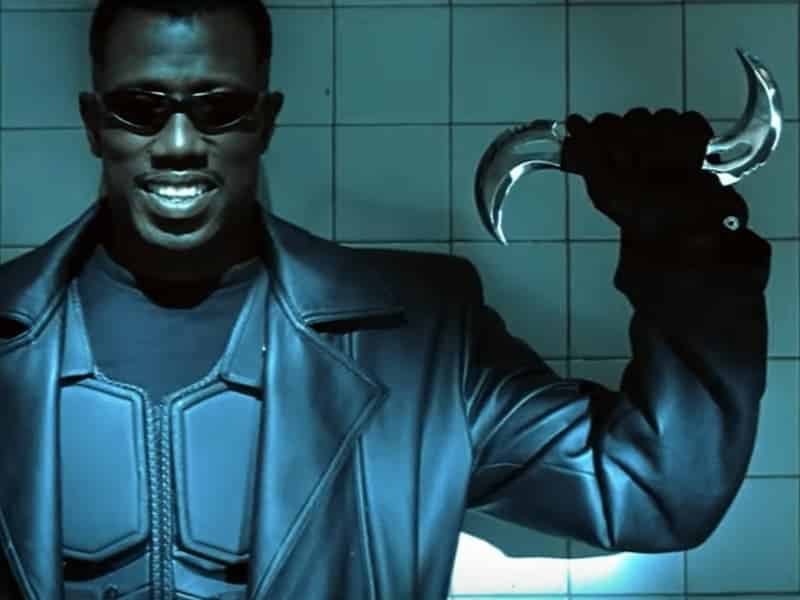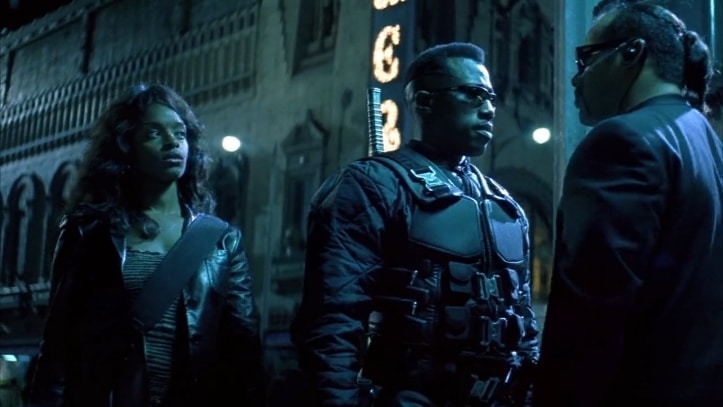
By Gabby Foor
Everyone’s familiar with all the vampire and superhero tropes by now; thank you Michael Morbius for doing all of them poorly. But almost a quarter century ago, as the nineties drew to a close, Marvel rolled the dice on this pitch-black hero horror film that would reshape its relationship with the R rating, blood, sex, drugs and the mouths on its characters. It was a left turn that brought Marvel critical and box office successes that would allow it to reach farther, creating the early successful blockbusters responsible for its ubiquity today. Blade was a rare gem that exists in a mostly brightly colored humorous universe that thrives on the “good guy” and violence that never pushes past CGI battles or intensely-thrown blows. It broke through failing box office predecessors, some so bad they couldn’t even survive the trip to video, but instead of worrying, Blade took a talented cast of stars and rewrote the comic book script to create a bloody mess where fans are still waiting for more.
In August of 1998, director Stephen Norrington released a Marvel-inspired movie on what would now be considered a meagre budget of $45 million dollars (adjust for inflation) – considering today’s Marvel movies clock in at a budget around $190,000,000 on average, as my research suggests. Headlining Wesley Snipes, Kris Kristofferson and Stephen Dorff, Blade was the first horror film and the first rated R feature the company would ever gamble on (sorry Deadpool, you weren’t first) after a short string of critical and box office failures. It was a bet that would garner them over $130 million at the box office ($70 million domestic, $60 million worldwide), positive critical reception, sequels, a reboot slated for 2024 starring academy award winner Mahershala Ali, and solidified cult status globally.
The iconic opening scene adeptly named ‘the blood bath’ is filmed in a dizzying meat packing warehouse and which was created once in Amsterdam, once in New York, god knows where else, with between 1,300-1,500 gallons of fake blood per party to simulate this dramatic entrance. We are introduced to our titular villains in an icy color palette, strobing lights and the reverberating bass of this dance party as the menacing pale faces of Deacon Frost (Stephen Dorff) and Quinn (Donal Logue) can be seen, stone cold and arrogant, surveying the club (it is their party after all). 90’s goth fashion has never been better: meshes, see through, all solid black and white outfits, blazers, bombers, bras and cowboy hats. This leather and latex period of style influence seen from films like The Matrix to Underworld permeates the Blade films too.
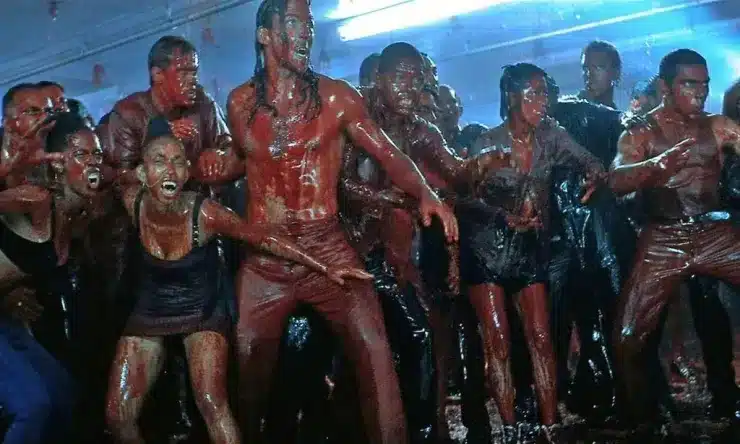
Blade, or Eric (Wesley Snipes) as we seldom hear him called, is another sad superhero tale of lost family. Bitten and killed by a vampire whilst pregnant, Blade’s mother is the first casualty of the film and a driving force behind his hatred for the beings. Due to her being bitten while pregnant, he has inherited some of the gifts vampires have: speed, strength, agility, but also the thirst. This tragedy and curse has earned him the moniker “The Day Walker.” With this, the aforementioned iconic bloodbath takes the time to show us some of our characters and introduce us to this predatory world, which soon turns into a different kind of blood bath when Blade arrives solo, exponentially outnumbered, but obviously not outclassed. The tools and skills that make Blade a deadly hunter are soon put on working display. Viciously sharp silver stakes and boomerangs turn bones to ashes and shotgun blasts disintegrate bodies as crowds flee. As a final parting gift, Blade traps one of his greatest foes, Deacon Frost’s right hand man, and sets him ablaze, alive, as a message.
In a city hospital, Quinn’s body is being looked at by hematologist Dr. Karen Jenson (N’Bushe Wright) who finds many irregularities and asks her ex, Curtis (Tim Guinee) to look at the body. As the two of them bicker back and forth about what might be causing all of the abnormalities in Quinn, he springs back to life, murdering Curtis, and biting Karen. Blade arrives and cuts off one of Quinn’s hands before he leaps from a window and into an ambulance (yeah, it’s fun to watch) and he turns to Karen. Faced with a choice, Blade sees the image of his mother in the dying woman’s face and risks being killed by the police to take her back to his safehouse to treat her bite and potentially reverse the transformation – with the aid of his mentor Abraham Whistler (Kris Kristofferson). Even at 25 years old, I’m reluctant to give many more spoilers as a new generation could watch this film in advance of the reboot.
Hard to Like, Easy to Love
Thor travels the universe with the Guardians of the Galaxy; Moon Knight has two wonderfully quirky alter egos; Blade is a less sensitive character. His rare smiles are usually brought on by being right, busting someone’s balls, or having a particularly satisfying kill. He’s not easy to relate to since he doesn’t volunteer much emotionally or give much in the way of “what are you thinking?”, and you can’t blame him for having attachment issues. Blade’s devotion to his cause and the trauma he suffered does give him some relatability however, and his past shines through in moments like when he spares Karen, and his fierce hunt through the second movie for Whistler.
Blade is not only faced with a mockery of his Dhampir origins by Deacon in the first film, but also his race. “Spare me the Uncle Tom routine,” Deacon casually shouts in a crowded park. He doesn’t care who hears; he’s attacking both Blade’s role as the Day Walker while also making it about race, similarly referring to all people as “pieces of meat.” The irony with Deacon in the film being that Deacon is also ashamed of his identity, as he is not a pure blood aka a “vampire by birth” and was merely “turned.” This theme follows into the sequel where a group of vampires led by Ron Perlman, The Blood Pack, confront Blade not about his role in the mission, but ask him first, “Can you blush?” This shows that not only do they look down on him as a pestilence to their kind, but they also disapprove of his skin color. They hate him to his core, and you feel anger or disapproval in moments on his behalf, as he is unshakeable in both instances, making him all the more admirable in his stand against the creatures and their prejudices.
Blade uses people to get what he wants: he steals, he kills, he destroys, all in the name of ridding the world of the plague that is vampirism, “cancer with a purpose,” as it’s referred to in the second film. The moral construct in Blade is always hazy, in that he is always looking for a means to an end. He may sometimes be hard to like, but in moments when he sees Karen suffering, or when Whistler is in agony, you do feel your emotions being pulled at. Blade has a heart he guards carefully with good reason, and we can all relate to that feeling of needing to keep a poker face and never tip your hand that something has moved you or something might be gnawing at you. Blade is still the wounded child somewhere within, but who wants to wear that as a mask? We’ll take his generally cold and apathetic temperament instead.
From the Comic Book…
Originally appearing in 1973, Blade was a side character in Marvel Comics’ The Tomb of Dracula #10 that went on to tell his own story. Blade is called a “Dhampir” in these comics, the “result of a union between human and vampire”, which gives him his enhanced abilities. Blade was edited throughout his conception to solidify his powers, and was initially written by Marv Wolfman and drawn by Gene Colan. Significantly adapted for the big screen, the comics tell a completely different story.
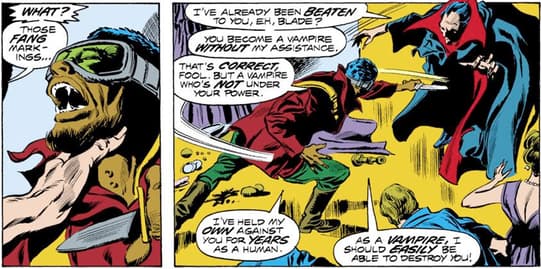
Across the pond, 1929, London, England is supposedly the birthplace of Eric Cross Brooks, born in a brothel. Due to complications with her labor, a doctor is brought to see Eric’s mother, who ends up being Deacon Frost, one of his most prominent foes in the comics and obviously in the first film. After she is killed and Frost is driven away by the other brothel workers, the workers then help raise young Eric. At age nine, returning to the brothel one night, Eric sees a man attacked by several vampires and helps distract the attackers while the hunter, as it turns out, Jamal Afari, kills them with a sword. This leads to a father-son like union between the two, as Afari teaches him music (he poses as a Jazz musician) and the methods to fight and effectively kill vampires. Eric’s skills with hand to hand combat and melee weapons earned him the moniker “Blade” as he uses knives, daggers and swords against his hated foes, who soon learn that Blade is someone to fear.
Blade engages with familiar characters like Dracula, Morbius, and Deacon Frost in these comics and paints a picture of a universe that could have been, including an alternate ending with Michael Morbius portrayed by Norrington himself. Deacon Frost was similarly heavily edited from comics to big screen, and I’m a fan of what they did. Originally an older man with light hair, in his middle age, with red eyes and a specifically German wardrobe. He is far more powerful in the comics than what we see on screen. The film ditches this image of Deacon, replacing him with Dorff’s youthful façade. He is more ancient and menacing in the comics, more of a “traditional” Anne Rice style vampire. The film spins Deacon as James Woods did with Hades, originally written as serious and somber in Disney’s Hercules but turned into the devil as a salesman. Dorff similarly reinvents and plays the role as a slick, manipulative young blood ready to kill and take anything he wants. I had the opportunity to meet Dorff this year and he still honors the role, as well as in interviews making no secret of his confidence in Ali’s ability to play the role. Asking politely how I spelled my name, showing his security my Blade tattoo (his personal glyph from the film adorns my leg) and signing off my poster with an all caps “Deacon Frost” in silver sharpie, he’s very much the charmer he portrays. This autograph is now the only thing I’d carry out of my burning house and made me all the more devoted to the film, meeting such a genuine person who still enjoys recounting his past performances.
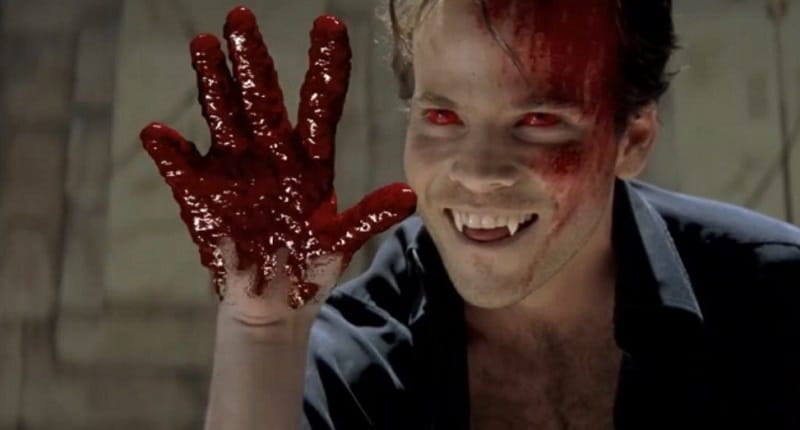
To the Big Screen…
Blade, much like Deacon, arrives on screen with a full character overhaul. Snipes fits the vision for the tattooed and stone-faced hunter with the athletic build Blade is supposed to have. It’s those around him that have been changed. Afari, the father figure in the comics, is replaced by a familiar Kris Kristofferson playing Abraham Whistler, who supposedly discovered Blade as a teenager, feeding in the streets, and took him in after his own family had been murdered by vampires years ago. Whistler fills the role nicely as I imagine the back story and inevitable killing of Afari would have taken an entire movie and robbed Blade of a mentor figure that Whistler provides through all three films.
The comic books suggest Blade had more of Marvel’s resources, like S.H.I.E.L.D., but in the film Blade is part of a small operation. Him and Whistler craft and repair their own weapons and vehicles, with the aid of some suppliers that help create the serum created in the films that keeps his thirst at bay. “How do you think we fund this operation? We’re not exactly the March of Dimes,” Blade quips as Karen comments on him robbing one of Deacon’s familiars. Their methods are dirty but successful, using witnesses as bait and hunting Deacon’s human henchman with cold efficiency. He is a detective, a scavenger and a hunter packed into one supercharged being. This serum is used throughout the films but not the comics and it’s implied that Karen improves upon it from the first to the second movie, as Blade has developed a tolerance, also showing how different characters carry value from film to film.
The vampires themselves are also redone. Blade rejected the Interview with a Vampire style blood sucker in exchange for a more modern, seductive appearance. There are hardly any older vampires seen out and about, and these are not monsters trying to hide. Deacon and his accomplices are costumed perfectly for their screen time and behave in more contemporary ways. On top of this, they are given some expensive CGI to work with – considering when this was made – for some of the film’s later scenes. They have their own technology, their own glyphs and their own language spoken behind closed doors. The actual language is supposedly peppered with real Russian and Czech words and phrases and is theorized by fans to be Eastern European in origin, possibly Slavic or Romanian. Even with all of this history, the vampires don’t feel stale or dated and nor do their familiars. Blood consumption is rare in the film for Blade himself, except for dire circumstances, showing Blade’s vampire nature and how it accelerates and enhances his superhuman abilities.
I still vividly remember the first time I heard the bone shattering, pulse pounding Pump Panel Remix of New Order’s Confusion blasting during the opening scene of Blade. Music included or done specifically for the films also elevates fight scenes and night-time meetups, with a hard-hitting soundtrack that can play a soothing “Dig This Vibe” by DJ Krush at a quiet party or “Playing with Lightning” by Expansion Union during the climactic final fight. The music, from Mark Isham, can range from the gothic, soaring strings and brass you imagine for an ancient evil such a vampire rising from the darkness, to the more modern, intensified beats that include prominent artists such as Massive Attack, Mos Def and the Crystal Method later in the series. These movies have soundtracks to make your playlist, and tracks to make a statement for whichever scene they accompany.
Final Thoughts…
Closing, you can probably guess this is my favorite movie and also the first horror movie I ever saw as a child. I have immense hope for the future of Blade, as I believe the trilogy ended on a weak note that deserved more. Blade landed in the final moments of the nineties and was a snapshot of the culture in film and fashion with its time period’s stars immortalized in the style. Blade couldn’t have happened without Marvel’s position to gamble on something out of the ordinary, and Blade couldn’t have thrived without the unique time period in which it was conceived between VHS and fiber optics, fighting between past and future much like its monsters. I believe its positive reception showed that darker heroes could have a place in the limelight both for critics and especially audiences, but its execution is so difficult (looking at you again Morbius) that gambling on the undertaking is a difficult risk to consider for studios, I would imagine, when the standard formula works.
After Blade, we see Marvel turn to a more family friendly image for over decades, only breaking tradition with Deadpool and a slightly edgy Moon Knight for its darker story lines and its only other R-rated franchise to date. This shows it still has cold feet, despite its successful past and a cast of stars willing to take the plunge into a project such as Blade. One of these stars, unsurprisingly, was a hunter named Hannibal King (Ryan Reynolds) from Blade III, prominent in the comics, who would go on to star as Deadpool. Keep that in mind if you, like me, wonder if there’s interest in livening up the universe.
With Mahershala leading, rumors of Kit Harrington joining, and “it girl” and certified scream queen Mia Goth generating buzz as one of the cast members, I’m hopeful Blade will come back as dark and brooding as ever, still committed to the mission. Currently being directed by Yann Demange (a producer of Lovecraft Country) after original director Bassam Tariq dropped due to “continued shifts in the production schedule”, I wonder if the introduction of more dramatic and famous actors and a more decorated director won’t shift the tone too intensely away from what the cinematic universe created prior, favoring rising stars like Dorff, Logue and Norman Reedus to fill major supporting roles. However, I’m open to new ideas, new or old characters from the films or comic books and a fresh journey I’ve been waiting on for decades. Blade opens next year against some fierce competition, and I’ll be in theaters rooting that it cuts down the competing Marvel films and re-establishes what made it the standard for hero horror.
